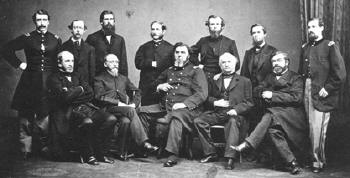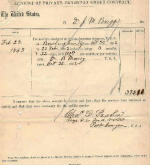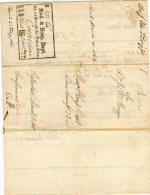Researching Civil War Surgeons & Physicians
United States Army Surgeons
Confederate States Army Surgeons
Contract Surgeons, Civilian Physicians & Surgeons
Research for Identification of doctors
|
Please note: this information is part of my personal notes and is used for research purposes only. The quotes from various sources are those books used to determine who was and wasn't a surgeon during the War. It is by no means a complete list of references or all the resources available to determine provenance of a given surgical set, surgeon, or doctor. Documenting provenance and determining who was or wasn't a surgeon is extremely difficult and can take hundreds of hours of research. Please...we are unable to respond to requests for information or research on any surgeon or individual, see:
Why this research is so difficult: "Almost 6,000 regimental medical officers, whose qualifications were initially ascertained at the state level, also served at one time or another in the Union Army. An equivalent number of civilian doctors unwilling or unable to join the Army worked as contract surgeons, either for short periods when necessity dictated or in general hospitals in the cities where they lived." Researching, doctors, physicians and surgeons on-line Your best bet, and what I do, is dig deep in Google digital 'Books'. I look in the regular web search area first, then dive into the digitized books under ‘more’. That's where you will find the medical college catalogues, medical associations, published papers, and the doctor’s names listed with any additional information, but there are some tricks to get the information to come up in the search. Read the Google advanced search information to learn how. Try Dogpile search for multiple search engines. Army: For Army Surgeon's, look on Google books: Regular Army Officers and their service records are published in Vol 1, Historical Register and Dictionary of the U. S. Army, ... by Francis R. Heitman
Navy: You can find pre-1900 US Navy officer service records online.
Try the doctor’s name with just the first and middle initials and last name plus 'm.d.'. Put the whole name and m.d. in " " so it looks up just that name. Try every variation as you see the names listed in lists. Think 1860, not 2010. Look for an obituary or biography for the doctor and then work backwards. With any luck an obituary will list where they went to college, where and if they served in the Civil War, and information about where they practiced. Try the search with 'dr.' instead of ‘md’ and with just the first name, all kinds of variations of the name will come up depending on what you add or omit. You have to be very specific with the physicians because the colleges and biography books frequently used just their initials plus last name. The ‘dr and md’ will only work after they graduated. Knowing the state and city are a big plus to weed out duplicate names. Also knowing and entering a date range on Google, e.g. 1840..1860 is a trick you may not know about . It's the '..' between dates that makes it work for a given range of dates. If you think the doctor was a U.S. Army surgeon, check the Roster of Regimental Surgeons (see below) in Google digital books. You can enter just the last name and then see what pops up, and go from there. (Note: not all surgeons were listed in the Roster, some were in state militias and may not show up in the Roster. None of the Confederate or contract surgeons will show up in the Roster. Only Union uniform wearing surgeons are listed in the Roster.) CSA surgeons are very difficult to find. Just keep trying everything you can think of in Google and especially Google Books. Try Cyndie’s List which has links to various surgeon and CSA groups. No one said this is easy and I’m sorry but I cannot help or do the research for you unless it is for something I am buying from you or you wish to sell to me. Resources I use to research Civil War surgeons: Again, start with Google Search, then use Google's digital 'Books' before you look anywhere else. Searching 'books' is different than searching normally in Google. If that doesn't turn up the name, then:
Note: (June 2010) If you want to research individual names of surgeons, I also suggest you check the web site run by Cornell Library MOA at: http://cdl.library.cornell.edu/moa/moa_browse.html This site will let you search the Medical and Surgical History of the War of the Rebellion. ...NO, I CANNOT DO IT FOR YOU! When confronted with a surgical set or other item which one wishes to identify and link with a given surgeon be prepared for a daunting task. There is no single source which gives you 'the' answer. There are a multitude of reasons for the difficulty in identifying a given doctor as having been a "Civil War" doctor. When the Civil War began, the Army Medical Department had a standing corps of medical officers, but no where near the number needed for the demand generated by the early battles of the War. As volunteers were processed and accepted for duty, the number of doctors increased greatly, but not all were accepted as Army Regulars, some were hired as contract doctors, especially the assistant surgeons. Few were experienced knife wielding surgeons. As quoted from the republished book by Wells and Strait "List of Battles and Roster of Regimental Surgeons", Edited by Ira M. Rutkow, M.D., ( Google Norman Publishing for a copy of this information) preface, Vl: The Northern medical services were organized into seven categories: 1. Surgeons and Assistant Surgeons of the United States Army. This was the regular Medical Corps and consisted of men in the service when the war began. The War began with only 90 medical officers, but was drastically expanded as the war commenced. 2. Surgeons and Assistant Surgeons of Volunteers. These were former "brigade surgeons" created by Congress to supplement the work of the regular staff surgeons. A total of 547 commissions were issued. 3. Regimental Surgeons and Assistant Surgeons, commissioned by state governors rather than congress or the President. There were 2,109 Surgeons and 3,882 Assistant Surgeons. (Note: these are some of the best documented surgeons and a list of their names is found in the "List of Battles and Roster of Regimental Surgeons", but the list is by no means complete for the Union surgeons. 4. Acting Assistant Surgeons, United States Army. These physicians were known as the 'contract' surgeons. They held no commission but received pay as first lieutenants. There were a total of 5,532 Acting Assistant Surgeons; most of which worked in the general hospitals in the North. They also continued their civilian practice at the same time. (Note: of all the so called "Civil War" surgeons, this group is the most difficult to identify. Without personal correspondence or other documents, it is very difficult to pinpoint any contract surgeon as being a 'Civil War' surgeon. Ownership of a given surgery set can help by dating that set via the makers address during the War.) 5. Medical officers of the Veterans Corps. 6. Acting Staff Surgeons. 7. Surgeons and Assistant Surgeons of the Colored Troops, who received presidential commissions. They were assigned to the Black troops The Medical Service of the Confederate States Army (CSA) is documented in Cunningham's Doctors in Gray. It is reported the Army and Navy of the CSA had 3,237 surgeons or assistant surgeons. These figures exclude contract physicians who were paid on a part-time basis while still in private practice. Unfortunately all official records of the Confederate States Army (CSA) Medical Corp were destroyed at the end of the War. However there are references to various CSA surgeons in the twelve volume: Medical and Surgical History of the War of the Rebellion. The following account (quotes) of Civil War surgeons is from the very fine book: American Surgery: An Illustrated History by Ira M. Rutkow, M.D. page 125 (again, available from Norman Publishing):
The following is a list of sites, books, or organizations where one can search for names and try to verify if a given doctor was or was not a surgeon or assistant surgeon during the War. Union records are more complete, but Confederate names are archived in various areas, but not to the same extent as the Northern surgeons. If you have a surgical set you suspect belonged to a Civil War surgeon it is extremely difficult research and very time consuming to do. Unless you can provide documentation of who owned a given set, it is highly unlikely you will be able to make positive identification. Army Surgeons from Yale Medical School c. 1864 Union Army surgeons: A History of the Army Medical Department: Civil War Medicine 1861-1865 by Mary C. Gilletty 1. (Available directly from the U.S. Government Printing Office, Dept. of Medical History) "The quality of the Army's contract physicians was important, since during the course of the war more than 5,500 civilian doctors assisted the Medical Department. Many routinely staffed general hospitals while others provided help only in emergencies when it was necessary to locate more physicians quickly. In the last group were some of the nation's most prominent doctors. When a battle resulted in overwhelming numbers of casualties, those who flocked to the scene might include quacks, cultists, and practitioners of questionable ethics, men who were not under military discipline and who could, therefore, come and go as they liked, taking assignments that pleased them and rejecting all others. They often performed unnecessary operations or wrought havoc as they dug about for bullets. As a result of the problems experienced with doctors so casually assembled, the Medical Department decided to call only upon members of a reserve surgeons corps formed by the governors of various states. These gentlemen were paid the salary of contract surgeons and came in if called. They served under Medical Department orders and were required to remain at their assigned posts at least fifteen days, unless officially released sooner." 1
Examples of a contract doctor pay documents from the medical department: Click on the thumbnails to enlarge
"The Medical Department had intended that its detailed and copious records concerning the Union's sick and wounded guarantee the emergence of something of value to medical science as well as to the Army from the most frightful conflict that the nation had ever faced. During the struggle and the months immediately following it, more than 12,000 medical officers- regulars, volunteers, and contract- examined over 250,000 wounds and treated more than 7 million cases of disease. In the course of their duties, more than 300 Army surgeons died from wounds, disease, or accidents."1
"Almost 6,000 regimental medical officers, whose qualifications were initially ascertained at the state level, also served at one time or another in the Union Army. An equivalent number of civilian doctors unwilling or unable to join the Army worked as contract surgeons, either for short periods when necessity dictated or in general hospitals in the cities where they lived."1
Please...we are unable to respond to requests for information or research on any surgeon or individual, see:
|




